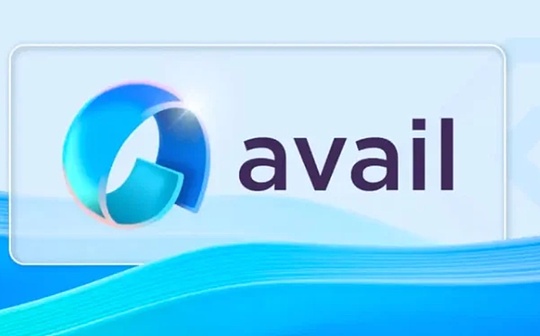
Author: Anurag Arjun, co -founder of Polygon, founder of Avail; translation: xiaozou@作 作 作 作 作 作 作 作 作 作
On February 26, 2024, Avail announced that it will receive a $ 27 million seed round financing led by Founders Fund and Dragonfly. Other well -known venture capital companies have also participated, including Sevenx, Figments, Nomad Capital and some angel investors.This round of financing will be used to promote the development of Avail Trinity -a three -stage roadmap that unifies the entire Web3 ecosystem.
>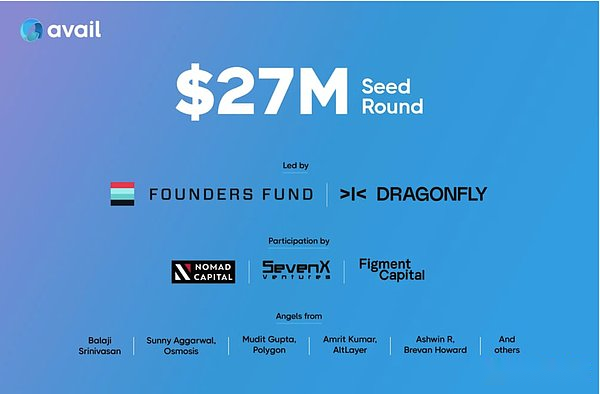
Polygon co -founder and Avail founder Anurag Arjun posted a document in depth the background and origin of “Avail Trinity”, and how Avail solves the problem of fragmentation and scalability of users facing today’s ecosystems.
>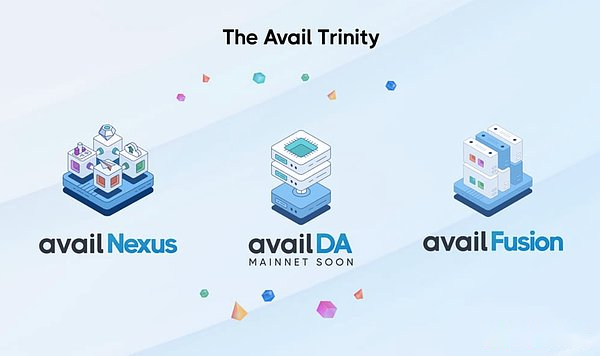
1. Summary
Web3 does not need to license the environment to give birth to a variety of breakthrough technologies. These technologies jointly promote the booming ecosystem today, and the development space of this ecosystem is still very large.If you want to reach the required scale you need to use, there are many technical challenges to overcome. The ecosystem has built a large number of innovative solutions based on the web3 technology stack.However, the problem that needs to be solved is to integrate all these technologies together as a overall operation of an end user, while maintaining the decentralized spirit of the ecosystem.
The complexity of cross -ecological system transactions exceeded expectations, leading to unnecessary fragmentation problems.Users’ efforts should tend to attract new users, not focusing on the existing Web3 community.
In order to solve all these problems, Avail is accelerating the unity of Web3 through Avail Trinity. The route chart is divided into three stages, which can provide the WEB3 experience of secure and seamless connections to the end users of any ecosystem.
In this article, we will explore the background and theory of Avail Trinity to show how it solves the problem of fragmentation and scalability of user fragmentation and scalability in today’s ecosystems.We will show how Avail Da lays perfect foundations for many ROLLUPs that are eager for high -efficiency data usability and lay the foundation for seamlessly realizing user intent (intent) through the Avail Nexus (a coordination center without permission).Avail Fusion Security has made Avail Trinity complete, solving the growing shared safety needs, and making the prosperous Web3 unified ecosystem stronger.
2. Foreword
If you have tried to trade across multi -chain networks, then you will know that the corresponding experience is not ready to welcome the large -scale adoption.
With a very profound technical understanding of the blockchain architecture, you can start to solve this long -term problem.Through the first principle of the first principle, we can get the technical foundation required to create a unified experience of the blockchain.This foundation will connect each independent L2 Rollup network and L1, and at the same time, it still supports developers with cross -ecosystems for decentralized innovation and experiments without permission.
Rollup is developed as part of the scalability challenge solution. It handles transactions under the chain and then packs multiple transactions into a single chain.Although rollup effectively reduces the cost and enhances the scalability of Ethereum, it brings new complexity:
● Due to limited availability, the demand for more block space has led to rising costs.
● The surge in the L2 ecosystem has exacerbated the fragmentation of the market and further hindered the user experience and the economy.
As these problems have been resolved, the scalability and interoperability potential of the blockchain system that has stopped for many years can finally be realized.
3. Avail solution
Avail is using the principle of asynchronous message transmission (the same principle as expanding applications on the Internet) to expand the blockchain, and now it is the best time to build.
Avail Trinity is composed of basic data availability (DA) layers, Nexus interoperability layers, and Fusion Security network layers.
● The DA layer is specially constructed for data availability. It is highly optimized. It is the bottom layer of the blockchain. It has the minimum function required to build a cross -ecosystem interoperability.
● NEXUS, as a lightweight but powerful ZK Rollup running on Avail, supports cross -Rollup and cross -ecological system settlement.
● Fusion Security can bring together many tokens’ encrypted economic security to serve and guarantee the Avail network.
Avail’s mission is to simplify the Rollup experience and provide an efficient unified platform for users and developers of all different ecosystems.
This vertical integration model aims to solve more and more troublesome and user fragmentation problems, enabling Rollup to seamlessly touch users and liquidity in the entire blockchain field.
Avail’s vision is to provide a consistent user experience in flexible modular blockchain ecosystems, and learn from Web2’s experience to innovate in Web3.Through the advanced technology, clear roadmap and rapid execution, Avail is not only building a product, but also to create a new stage for the blockchain field.Ping the road.
4. Background and inspiration
What can we do from web2?
How is the application on the Internet really achieve scale?Asynchronous micro -service.
The Internet is not a huge world computer, but a series of computers connected to each other. They perform specific tasks according to business cases and communicate with each other when needed.
Amazon is a group of related microservices specializing in e -commerce.VISA operates a series of microservices for payment.
● When the user clicks the product purchase button on Amazon, it will trigger the call from the browser to Amazon product microservices.
● Then call VISA micro -service to send the payment page to users.
● Once the user fills in the payment details, another verification payment request will be sent to VISA microservices.
● Once the payment passes the verification, it will send a callback to the Amazon product microservice, so that users know that the product has been purchased and the payment has been completed.
If you encounter a holiday promotional day such as Black Friday, Amazon and VISA micro -service will expand the scale to meet more Internet needs.
The point is that the Internet can only expand to such a large scale through asynchronous micro -service.This will also be the same.
How do we implement this in web3?
UPI is a good example.As far as users and transactions are concerned, it is one of the largest payment systems in the world.At present, UPI’s monthly handling transactions exceed 10 billion, which proves that the system is large.
UPI is a system that enables customers of different banks to interact.But it was not so successful when it was launched.The bank was very hesitant to whether to join the system -the government did not force the request to join UPI.Banks said that the main concern is that if they support UPI transactions, the end result will be that the funds in the customer account will be transferred to other banks (liquidity outflow).
Solving this problem uses the principle of reciprocity.The principle of reciprocity replaces economic incentives, which is used to convey such a concept: Only when banks allow “Pay-OUT” (paid outward) can they join UPI to obtain “Pay-in” (Payment Flow Inlets “(Payment Flowing Inlets”To.
Although this is an example of the required permit set (bank in Web2), the uniform layer of Web3 should still be embedded in the principle of mutual benefit, which is good and harmless for the entire ecosystem.
The principle of reciprocity helps all banks open the door of their customers and wallets to ensure effective cooperation to ensure that the final customers get the best user experience as much as possible.
Such cooperation is harmless to the ecosystem.But this can only be achieved only when the underlying technology is used to achieve cooperation.UPI has these, we designed Avail to bring global experience of Web2 system into Web3.
Bring the experience of web2 into the web3
The development of the Internet provides precious insights to the blockchain world.The expansion of the Internet is mainly achieved through asynchronous micro -services. Asynchronous micro -service is a network composed of interconnected computers. Each computer performs specific tasks and communicates when required.
● platforms such as Amazon and Visa are examples of this model. They provide a series of special microservices for e -commerce and payment processing.
● These services independently expand to meet demand and show the effectiveness of decentralized asynchronous operations.
● The success of systems such as UPI (unified payment interface) further highlights the importance of connectivity in expanding large -scale complex systems.
In Web3, we are witnessing a similar complexity and growth stage.Today, many Rollup and Layer 2 solutions have appeared on Ethereum, which has led to the fragmented problems of users and liquidity, as well as the disconnection of user experience, reminiscent of early Internet challenges.Now let’s understand these issues in depth, and how Avail helps solve these problems.
Modular ecosystem status quo
Rollup has become a recognized blockchain expansion solution.With the maturity and development of ROLLUP technology, as well as new advanced technologies specific to applications, they are becoming the standard function of blockchain platforms.We see that Rollup is getting more and more adoption of multi -chain, which is obvious.
However, this development has attracted a lot of attention to user experience, because there are hundreds of chains, and each chain has countless user interaction.
The main L2 participants have formulated their own unique solutions in the process of dealing with these challenges.Unfortunately, this has led to further fragmentation.
Although these ecosystems allow smooth integration operations within their boundaries, cross -ecosystem operations can produce friction, which is a obstacle to users seeking seamless interoperability in a wider range of blockchain fields.
>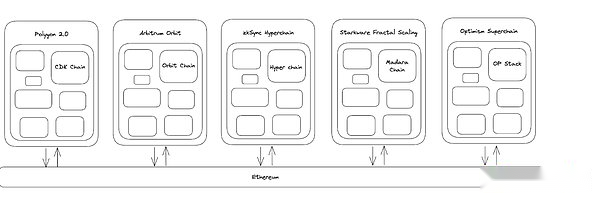
DA layer based on validity proof
Based on the first principle of thinking, the underlying layer of the unified stack needs to be a DA layer built by the availability sample based on the effective proof of validity.
The DA layer is an essential layer in the blockchain because it is the integration point of consensus and sorting.Although the DA layer needs other components (that is, execute) to build a blockchain, it acts as the root of trust, sorting the transaction and reaching consensus on these transactions.
When the execution layer is checked and sorted from the basic layer and the DA guarantee, the most effective and minimum execution method is to sample the sorting commitment.Based on the proof of validity, it is an irreversible source of facts.This is exactly what KZG promises to play in Avail Da.However, in order to obtain the availability guarantee for sorting, the client must either download complete data or perform sampling of the default data data to provide high credibility availability.The former forced the client to run the basic layer of the entire node, so Avail enables the light client of the DAS to execute DAS to the correction code data to efficiently verify the availability.
Validity proof supports DAS is Avail Da’s superpowers, which is our fulcrum for our construction of Avail Trinity.
Avail trinity
The Avail ecosystem aims to provide users and developers with an excellent experience, and balances scalability, interoperability, and security without compromise.The structure of the platform is mainly the following three floors:
● Basic data usability (DA) layer
This layer is a general base layer, and any blockchain can use it to enhance its scalability and security.The simple and powerful design of the Avail DA is very flexible. It meets the needs of each chain and does not impose specific constraints or prejudices.
● Facing interoperable Nexus layer
The Nexus layer is a coordinated component of Avail, which provides a framework that does not need to be licensed for ROLLUP internal message transmission.
This layer is essential for creating a seamless user experience of crossing multiple scenarios. Whether the user uses a single Rollup, or crossing multiple ROLLUP across Avail, or interacting with the chain in the external ecosystem.
● Fusion safety layer
Fusion allows Avail Basic Chain to combine non -native token with Avail native token to protect the security of the Avail platform, thereby achieving a strong and reliable security layer.
Fusion Security will provide higher security and more effectiveness for built Rollup tokens built on Avail.
Fusion will also help introduce more liquidity of other blockchain into the Avail ecosystem and lock it.
5. Avail Da
>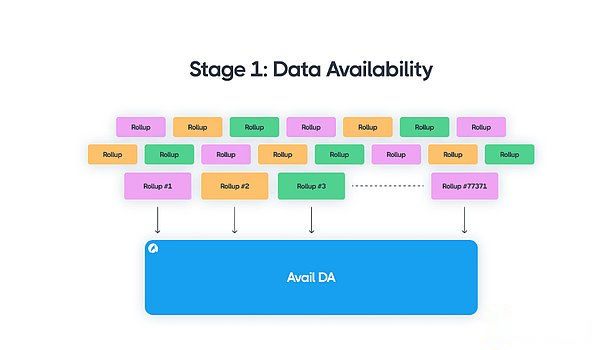
The DA layer is the core foundation of the blockchain network, which acts as the extensible sharing factory.It ensures that every time a new block is born, all the relevant data in the network are there without any hidden or delete, thereby supporting it to continue running.
Although it is important, the DA layer needs other layers to create a blockchain, especially the execution layer that determines the changes in the state of the blockchain.The execution layer is efficiently expanded through rollup, but if there is no optimized DA layer, data availability will soon become a bottleneck.
(1) The working principle of the Avail DA layer
The Avail DA layer is a decentralized blockchain network.It creates block space and ensures its safety. Other blockchain can use these block space as its own data availability layer.
Use a special Appid to publish transaction data to Avail, and then these data are submitted and become available.
>
● The data published on the Avail block is verified by the Avail network, but it is not executed (because this is the work of the execution layer).
● Avail data available blockchain can support any blockchain network.
● Avail uses validity proof, so developers and users do not need to trust Avail network confirmation data to be available; they can verify themselves.
● The data published to Avail is expanded by the compact code, which increases data redundancy.
● Avail uses KZG polynomial commitments to ensure that the data leaves traces in the Avail block head.
● Once the new block is verified, it is finally determined that the validity proof can be used to ensure that the data is available immediately after the block is confirmed.
● Avail’s nomination equity certificate (NPOS) blockchain is built using Polkadot SDK, which will support up to 1,000 external authentication.
(2) Data availability sampling (DAS)
DAS is a core concept that effectively verifies other networks, wallets and data available on the AVail blockchain.
Using Avail’s Light Client, users can sample the Avail blockchain quickly to verify the validity proof of the data available.This efficient and concise code can be easily deployed on different products and devices, including users’ mobile phones and browsers.
>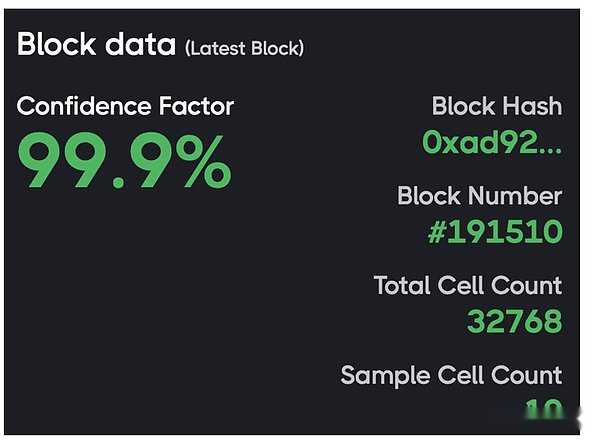
8. Extension ability
Through Avail’s light client and data availability sampling, Avail supports scalable blocks, which can increase the size of the block and support more blocks with the growth of demand.
This is due to the unique features of light clients and DAS.
The Avail Light Client can sample the data subsets in the network and verify the availability of the data.The light client can quickly generate nearly 100%data availability guarantee through 8-30 samples, providing a security guarantee that is equivalent to the full node.When the cross -light client network is copied, the light client network itself begins to form a copy of the current state of the chain, adding redundancy to the entire network.In the end, you will get a copy of the Avail network with a verification device and a light client network.
With more light clients, the network has more powerful data sampling capabilities.With more DAS in the network, the coverage of the light client network will become large enough to sample a larger block.This will bring a positive feedback cycle, that is, as the block space becomes larger and larger, the number of light clients in the network will be increasing.Contrary to the single chain design with reduced available block space as demand, Avail’s DA layer will be able to expand the DA block space according to demand.
9. Maintain sorting
Maintaining transaction sorting is the basic requirements for building the blockchain system.With the emergence of each new Avail block, new sorting transactions on the blockchain will appear.
Although the responsibility for the release of data sorting is the Avail DA verification device set, the verification responsibility is outsourced to users.In order to determine the correctness of the chain, the user must:
● Verification data usability: It is based on the established sorting data usability.Users can implement this based on the sorting of the sorting data determined by the Avail verification device set.The effectiveness of Avail’s use of the effectiveness of Avail DA can achieve the final certainty of about 60 seconds. It can be said that the fastest final certainty guarantee that can provide today’s DA layer.
● Verification execution: This is implemented by verifying the execution proof of Rollup.
In fact, by default, these verification processes will be integrated into the user wallet.This integration ensures that users do not need to have verification technology, nor do they need to run special software.This method not only simplifies the user experience, but also maintains the reliability and integrity of the interaction in the Avail ecosystem.
6. Avail Nexus
>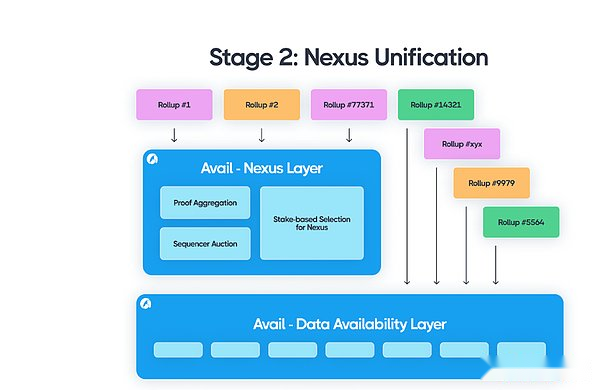
Being able to easily support ROLLUP easily means that the arrival of thousands of Rollup will usher in.In other words, the end user experience of interacting with these Rollup will be fragmented.In the multi -chain world, the experience of blockchain users has been affected to some extent. If further the number of ROLLUP is further increased without changing the combined ability, it will bring more serious problems.This is why we are building Avail NEXUS, which is used as a unified verification center for ROLLUP and using Avail DA as the root of trust.
Avail Nexus is based on Avail’s custom ZK coordination Rollup, including:
● Prove the aggregation and verification layer
● Sortter/SLOT auction mechanism
Nexus will also be aggregated to proof of regularly submitted to Ethereum and Avail DA layers for verification.A custom module in Avail DA is verified to verify the aggregation proof.
background
Rollup is crucial to solving scalability problems.When it involves attracting more users, the single chain is always a bottleneck.In the ideal future, each DAPP is its own rollup, which is only limited by its own performance.However, the most important part of this future is seamless communication between DAPP.The modular world will definitely be as efficient as a message transmission protocol that indicates across rollup.
Cross -rollup communication involves cross -chain bridges. If it is comparable to the security provided by the single chain, it is important for these cross -chain bridges.When a bridge is performed between the ROLLUP on the same DA layer, it will not involve cross -trust and security areas, because they all depend on the same consensus and economic security to determine sorting (there is a slight difference)In terms of, Rollup needs to know whether execution is correct. This is very important. It must verify it by itself so that it does not have to trust others to rely on it to provide these guarantees.This leads to a series of important issues.
● How to verify the state without becoming a bottleneck?
● How do ROLLUP understand the message or events on other rollup in the ecosystem, and can the message transmission be achieved asynchronous?
● How can Rollup A know the specifications of Rollup B?
● Safety assumes that there are changes between different Rollup?
● How many cross -chain bridges are needed, even if they are universal?
Avail Nexus aims to solve these problems in a large scale.
design
When a blockchain wants to talk to another chain, for its own safety, it needs to answer two important questions.
1. What is the norm and final order of the chain?
2. Is the execution effective?
Consensus determines the standard order of the chain, and the GM -DA layer provides a unified security in this regard.The DA layer provides ROLLUPS consensus for its transaction order. For Rollups with the same DA layer, this is to change the rules of the game.The transaction order of all Rollup (including its own Rollup) is determined by the same consensus, so even if there is a reorganization, the order of all rollup will be determined by the reorganization.
However, even for ROLLUP with a public DA layer, it is also a problem to determine whether the execution is effective.
Let’s imagine the situation of NFT Rollup who wants to confirm the payment on the payment Rollup.Cross -rollup communication is roughly shown as follows:
>
The red line represents the information flow from paying Rollup to NFT Rollup.Although this looks simple, the complexity will increase as more Rollup joins the ecosystem.
Even for some rollups who want to communicate with each other, the structure will eventually look like this. There are unique bridge instances between them to perform all the above functions.
>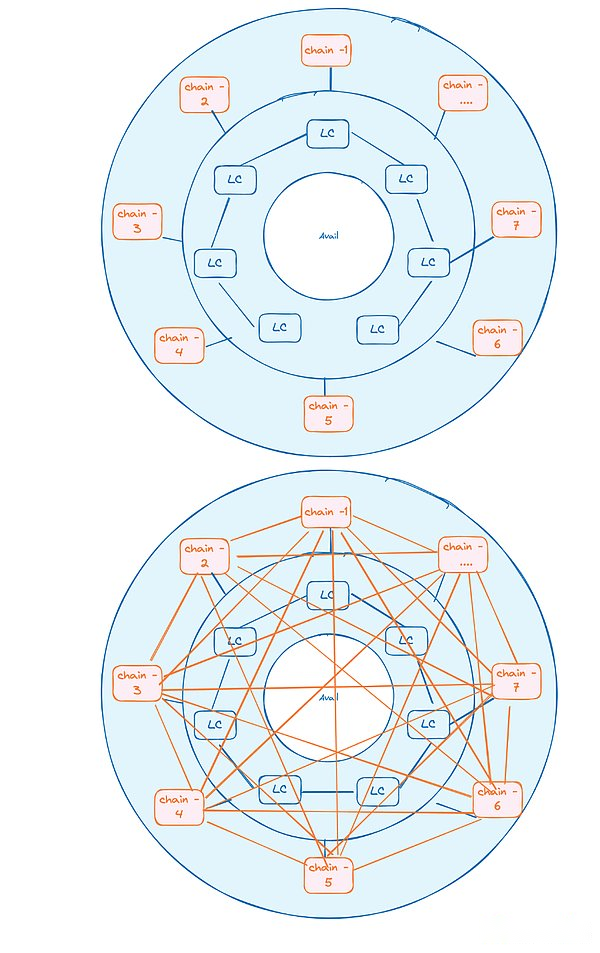
When we recognize that each rollup may have a unique state conversion function and the customized design selection according to its specific field, the challenge becomes more obvious.The verification of execution may depend on game theory, combined with fraud certification or dependence on the effective proof system of zero -knowledge certification (ZK certificate).Even in ZK Rollups, the proof of the system itself may show changes, from Groth16 to Plonk.
Rollup does not really need to know what the details and status conversion functions of other rollups are, but only need to verify whether the execution of these state conversion functions is implemented truthfully, and you need to understand these execution related to them.In addition, by verifying a single proof, whether they can basically verify all the effectiveness of all execution to them, this will change the rules of the game.The verification center enables certain interfaces for cross -chain communications and events, and the detailed information of the specific domain of Rollup behind it is provided for this.Avail Nexus is the embodiment of this concept.
>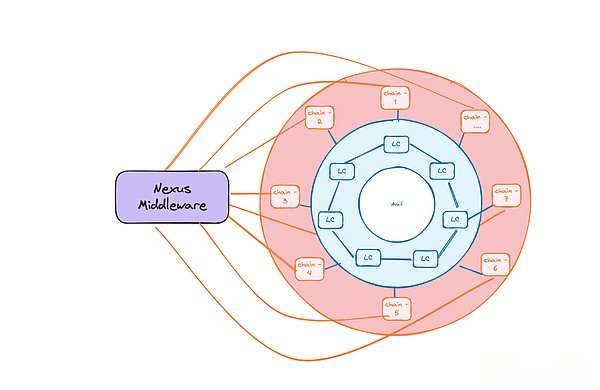
Aggregate
ZK proves that there is a very important feature, that is simplicity.The computing resources required for verification statements are much less than the sentence itself.In the context of the blockchain, status verification is much easier to reach a certain state than to reach a state by executing the state conversion function.In addition, the possibility that the n proof is effective through a single certificate (aggregation) is possibilities.Now, we no longer need to verify the validity proof of Rollup alone, but to verify that a single aggregation certificate will verify all the effective proof of participating in the Rollup as of this point, which means the effectiveness of all historical records involved in Rollup.
Avail Nexus will verify all the validity proof submitted to it when it meets certain conditions, and create a concise proof to prove that this operation has been completed.The proof is then submitted to the Avail base layer and verified by all nodes.In essence, it becomes a sacred settlement layer.Any participating Rollup can verify this simple proof to verify any other RollUp. Most importantly, through the L1 bridge, the world can access the outside world.
>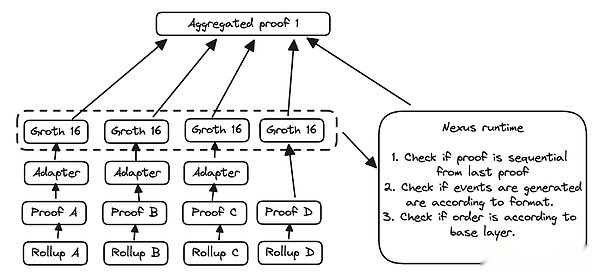
The details of the implementation may change, but you can verify the proof or use more target certification aggregation tools (eg
An important detail is that Avail Nexus itself is a ZK Rollup.Each aggregation is a new block or Batch in the Rollup world.The block head is a promise of a certain state, which is used to store the Rollup block header before NEXUS, and the list of all events generated by Rollup as of this point.In addition, this is even allowed to participate in the optimistic Rollup.Optimistic ROLLUP will be able to submit its receipts and status roots to Nexus, and the fraud proves will be a provenance of ZK fraud, thereby shortening the challenge period.If the fraudulent certificate is not submitted during the challenge period, the receipt (or event) generated by the optimistic Rollup will be included in the NEXUS state.
Back to the example of NFT and payment, the realization now looks like this.
>
The orange part describes the flow of information between the two chains.The receipt provided by Avail Nexus describes the root of all events built by all rollup generated by all rollup in historical records.It is important that it can be proved to the incident that it contains non -inclusive proof.In the current implementation, the event is all stored as a sparse Merkle tree. The hash value of the event is used as its index, and Nexus forced each event to be unique.
Synchronous combination applications can accurately predict and are easier to build.However, with the expansion of use cases and the improvement of user experience requirements, synchronous combinations cannot provide sufficient flexibility.In a single -chip chain or a single Rollup, the application is located in the same system, and it is easy to have two structures at the same time.Any communication between applications needs to be performed within the block time, but a high -level structure like Future can be used to store future commitments. When these Future implements it, some pre -submitted executions can be completed (we are inKnowing that they are callback).
When we shift from a single -chain world to a modular world with many Rollup, the need for combined asynchronous combined needs becomes more obvious.The situation of a chain stop is not ideal because it is waiting for the payment on another chain.Any type of communication needs to be able to across multiple blocks.In addition, the atomic attributes have become important for any asynchronous combination system.The execution of all parts needs to be recovered when the external conditions fail.As shown above, these are the challenges solved by Avail Nexus.Avail Nexus provides a unified experience in the modular world through aggregation proof.This allows customized implementation such as FUTURE storage and provides future completion across the system.(In this structure, Rollup itself does not recover due to external failures, but Rollup will enter a new state and be canceled in the future.) In essence, only after the payment is completed can the NFT be transferred to someone.Payment ROLLUP, just like the UX we are familiar with in the world of web2.
Order and execution verification
Today, Rollups on Ethereum bears the cost of using Ethereum as DA.When the GAS fee rises, the cost they pay is about $ 1300-1600/MB, or even higher.Therefore, we see that many chains want to use Avail as the DA layer of its chain.This can reduce the operating cost of 70-90%, depending on their construction choices and BATCH size.They still issued proofs on Ethereum and used it as a settlement layer.In fact, they just use Ethereum as their norm bridge.
Although we will continue to see this trend in the next few months, in fact, if hundreds of rollups per block solve on Ethereum, the execution of Ethereum will not be expanded again.We hope that Avail validators will continue to establish a bridge on Ethereum in order to access users and liquidity there.But we will share the cost of the bridge through Avail NEXUS.
The Rollup participating in Avail Nexus will be proved by Avail Rollup and verified.Verified proofs will reach Ethereum via the Vector Bridge. The Vector Bridge is a consensus -based consensus proof bridge from Avail to Ethereum.Ethereum can still verify the polymerization proof of execution, and does not need to rely on Avail verification. Except for DA and sequence, this is the same as the assumptions of Validiums.
The only difference now is that Avail Nexus has become a norm bridge of Rollup, while Ethereum uses the same bridge to guarantee.The design reduces the cost of execution on Ethereum, from each verification verification to a single certificate that proves to verify all rollups participating in Avail NEXUS.Then, rollup can exit on Ethereum like normal.
7. Avail Fusion
>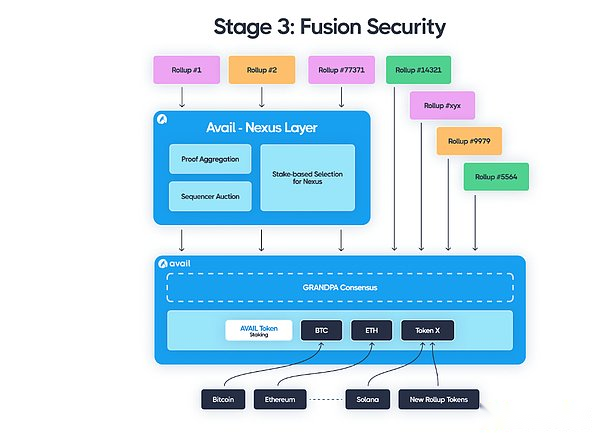
The unified layer requires unified security.Establishing a new Rollup rather than the greatest value proposition of creating a separate L1 is to inherit security from the basic layer.To make Avail a WEB3 coordination layer, it needs to be very safe because the encrypted economy guarantee and encryption guarantee will ultimately define the Avail ecosystem.
To satisfy this, we are developing Fusion Security that uses the most mature native assets of the ecosystem, such as BTC, ETH, etc., and allows them to contribute to Avail consensus.Not only that, it also allows the new RollUP tokens to play a role in protecting the basic layer, thereby giving them power.
Fusion Security is an additional encrypted economy security, which aims to realize the unified vision of Avail.
In the context of the Avail platform, Fusion Security allows external tokens other than Avail’s native token in the Avail DA consensus.
Fusion allows adding two tokens to the pledged library of Avail, thereby enhancing the encrypted economic security of the entire ecosystem:
● Mature cryptocurrency: BTC, ETH and SOL tokens.
● Emerging RollUP tokens: The new tokens created on Avail are limited to a small part of the total pledge to guide its utility.
This method will gradually enhance the economic security of Avail, and marks one of the first examples of the first batch of consensus on different blockchains using external tokens such as ETH and BTC.
At present, the Fusion prototype developed for Avail follows two different methods:
1. pledge module on the Avail blockchain: This module will support a variety of external tokens through the asset pallets in the Avail node.
2. Pure module for asset conversion: This will make external assets be converted into Avail’s native currencies and maintain price conversion mapping during conversion.
The final choice of these methods will be determined after careful consideration of economic risk models, inflation constraints, and other key factors.This measure represents an important step in the integration and interoperability of various cryptocurrencies in the Avail ecosystem.
Fusion’s inspiration comes from:
● EIGENLAYER, which created a service in the service independent of Ethereum consensus mechanism or complete verification service service, repossented ETH
● Babylon Chain, is creating a platform that allows the use of BTC (Bitcoin) to ensure security through different blockchain networks
● OSMOSIS, which creates network security, allows a chain to borrow economic security from other chains
Fusion is a structure similar to these methods.It borrows the economic security of other assets, but punishs the failure and active failure in Avail consensus.
8. Avail tokens
Avail tokens will promote the circular economy in the network
● DA, nexus, and Fusion security layer will be protected through the Avail token pledge
● Transaction and bridge fees are paid by Avail’s native token to ensure that the network can maintain itself and provide consistent incentive measures for all participants
>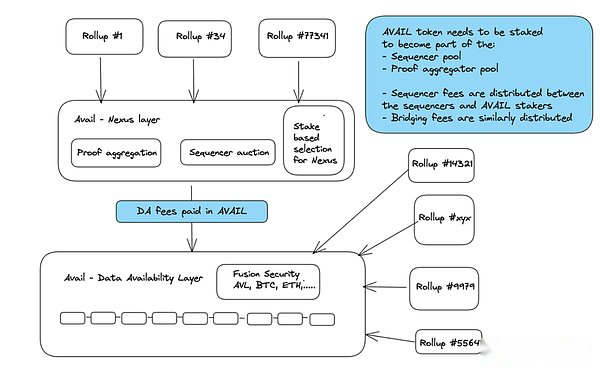
Avail token holders will form a basic community that hopes to build and use the advantages of the Avail ecosystem on Avail DA.
9. Unified vision
In an environment composed of hundreds of chains, each chain has its own security and interoperability factors. Avail’s goal is to become a platform that provides seamless and unified experiences in the entire ecosystem.
The platform will provide a single user interface that allows users to easily manage all assets on each blockchain.When the user wants to execute the transaction, they only need to sign the intention on the interface.
Then, the back end of the Avail platform will use Avail NEXUS and its support for asynchronous messages to start operations.The system communicates with other chains in the ecosystem to meet the requests of users and ensure a smooth, efficient and unified web3 user experience.








